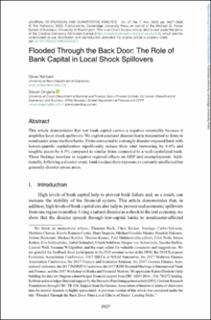| dc.contributor.author | Rehbein, Oliver | |
| dc.contributor.author | Ongena, Steven Roger G. | |
| dc.date.accessioned | 2023-01-30T13:46:18Z | |
| dc.date.available | 2023-01-30T13:46:18Z | |
| dc.date.created | 2022-10-24T06:52:25Z | |
| dc.date.issued | 2022 | |
| dc.identifier.issn | 0022-1090 | |
| dc.identifier.uri | https://hdl.handle.net/11250/3047184 | |
| dc.description.abstract | This article demonstrates that low bank capital carries a negative externality because it amplifies local shock spillovers. We exploit a natural disaster that is transmitted to firms in nondisaster areas via their banks. Firms connected to a strongly disaster-exposed bank with lowest-quartile capitalization significantly reduce their total borrowing by 6.6% and tangible assets by 6.9% compared to similar firms connected to a well-capitalized bank. These findings translate to negative regional effects on GDP and unemployment. Additionally, following a disaster event, banks reduce their exposure to currently unaffected but generally disaster-prone areas. | en_US |
| dc.language.iso | eng | en_US |
| dc.publisher | Cambridge University Press | en_US |
| dc.rights | Navngivelse 4.0 Internasjonal | * |
| dc.rights.uri | http://creativecommons.org/licenses/by/4.0/deed.no | * |
| dc.title | Flooded Through the Back Door: The Role of Bank Capital in Local Shock Spillovers | en_US |
| dc.title.alternative | Flooded Through the Back Door: The Role of Bank Capital in Local Shock Spillovers | en_US |
| dc.type | Peer reviewed | en_US |
| dc.type | Journal article | en_US |
| dc.description.version | publishedVersion | en_US |
| dc.source.journal | Journal of Financial and Quantitative Analysis | en_US |
| dc.identifier.doi | 10.1017/S0022109022000321 | |
| dc.identifier.cristin | 2064099 | |
| cristin.ispublished | true | |
| cristin.fulltext | postprint | |
| cristin.fulltext | original | |
| cristin.qualitycode | 2 | |

